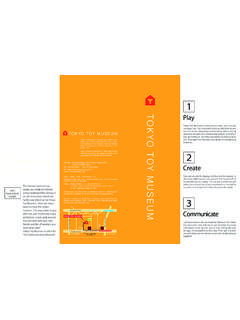Transcription of The Impact of Technology on Child Sensory and …
1 The Impact of Technology on Child Sensory and Motor Development by Cris Rowan, OTR Reminiscing about growing up in the good old days is a memory trip well worth taking, when trying to understand the issues facing the children of today. A mere 20 years ago, children used to play outside all day, riding bikes, playing sports and building forts. Masters of imaginary games, children of the past created their own form of play that didn t require costly equipment or parental supervision. Children of the past a lot, and their Sensory world was nature-based and simple. In the past, family time was often spent doing chores, and children had expectations to meet on a daily basis.
2 The dining room table was a central place where families came together to eat and talk about their day, and, in between meals, the table was the center for baking, crafts and homework. Today s families are different. Technology s Impact on the 21st century family is fracturing its very foundation and causing a disintegration of core values that used to hold families together. Juggling work, home and community lives, parents now rely heavily on communication, information and transportation Technology to make their lives faster and more efficient. Entertainment Technology (TV, internet, video games, iPods) has advanced so rapidly that families have scarcely noticed the significant Impact and changes to their family structure and lifestyles.
3 Elementary aged children use, on average, eight hours per day of entertainment Technology , and 65% of these children have TVs in their bedroom, with 50% of North American homes have the TV on all day (1,2). Add emails, cell phones, internet surfing, and chat lines, and we begin to see the pervasive aspects of Technology on our home lives and family milieu. Gone is dining room table conversation, replaced by the big screen and take out food. Children now rely on Technology for the majority of their play, grossly limiting challenges to their creativity and imaginations, as well as limiting necessary challenges to their bodies to achieve optimal Sensory and motor development.
4 Sedentary bodies bombarded with chaotic Sensory stimulation are resulting in delays in attaining developmental milestones, with subsequent Impact on basic foundation skills for achieving literacy (3,4), causing France to ban all Baby TV (5). Violent content found in media has had such an Impact on Child aggression, that the United States has classified media violence as a public health risk (6,7). Hard-wired for high speed, today s young are entering school struggling with self-regulation and attention skills necessary for learning, eventually becoming significant behavior management problems for teachers in the classroom.
5 So what is the Impact of Technology on the developing Child ? Children s developing Sensory and motor systems have not evolved biologically to accommodate the sedentary, yet frenzied and chaotic nature of today s Technology . Rapidly advancing Technology has contributed to an increase of physical, psychological and behavior disorders that the health and education systems are just beginning to detect, much less understand. One in six children have a diagnosed developmental disability (8), one in six are obese (9), and have a diagnosed psychiatric disorder (10). Diagnoses of ADHD, autism, coordination disorder, Sensory processing disorder, anxiety, depression, and sleep disorders can be causally linked to Technology overuse and are increasing at an alarming rate (11-16).
6 An urgent closer look at the critical factors for meeting developmental milestones, and the subsequent Impact of Technology on those factors, would assist parents, teachers and health professionals to better understand the complexities of this issue and to help create effective strategies to reduce Technology use. The three critical factors for healthy physical and psychological Child development are movement, touch and connection to other humans. Movement, touch and connection are forms of essential Sensory input that are integral for the eventual development of a Child s motor and attachment systems.
7 When movement, touch and connection are deprived, devastating consequences occur (17-19). Young children require three to four hours per day of active rough and tumble play to achieve adequate Sensory stimulation to their vestibular, proprioceptive and tactile systems for normal development (20,21). The critical period for attachment development is from birth to seven months, where the infant-parent bond is best facilitated by close contact with the primary parent and by lots of eye contact (22). These types of Sensory inputs ensure normal development of posture, bilateral coordination, optimal arousal states and self-regulation necessary for achieving foundation skills for eventual school entry.
8 Infants with low tone, toddlers failing to reach motor milestones, and children who are unable to pay attention or achieve basic foundation skills for literacy are frequent visitors to pediatric physiotherapy and occupational therapy clinics (16). The use of safety restraint devices, such as infant bucket seats and toddler-carrying packs and strollers, have further limited movement, touch and connection, as have TV and video game overuse. Many of today s parents perceive that outdoor play is unsafe, further limiting essential developmental components usually attained in outdoor rough and tumble play (23).
9 Dr. Ashley Montagu, who has extensively studied the developing tactile Sensory system, reports that when infants are deprived of human connection and touch, they fail to thrive, and many eventually die. Dr. Montagu states that touch-deprived infants develop into toddlers who exhibit excessive agitation and anxiety and may become depressed by early childhood. As children are connecting more and more to Technology , society is seeing a disconnection from themselves, others and nature. As little children develop and form their identity, they often are incapable of discerning whether they are the killing machine seen on TV and in video games, or just a shy and lonely little kid in need of a friend (24).
10 TV and video game addiction is causing an irreversible worldwide epidemic of mental and physical health disorders (25), yet Technology overuse contuse to escalate in both home and school settings. Where 100 years ago we needed to move to survive, we are now under the assumption we need Technology to survive. The catch is that Technology is killing what we love the with other human beings. Connection is integral to that developing Child s sense of security and safety. Healthy attachment formation results in a happy and calm Child . Disruption or neglect of primary attachment results in an anxious and agitated Child .



